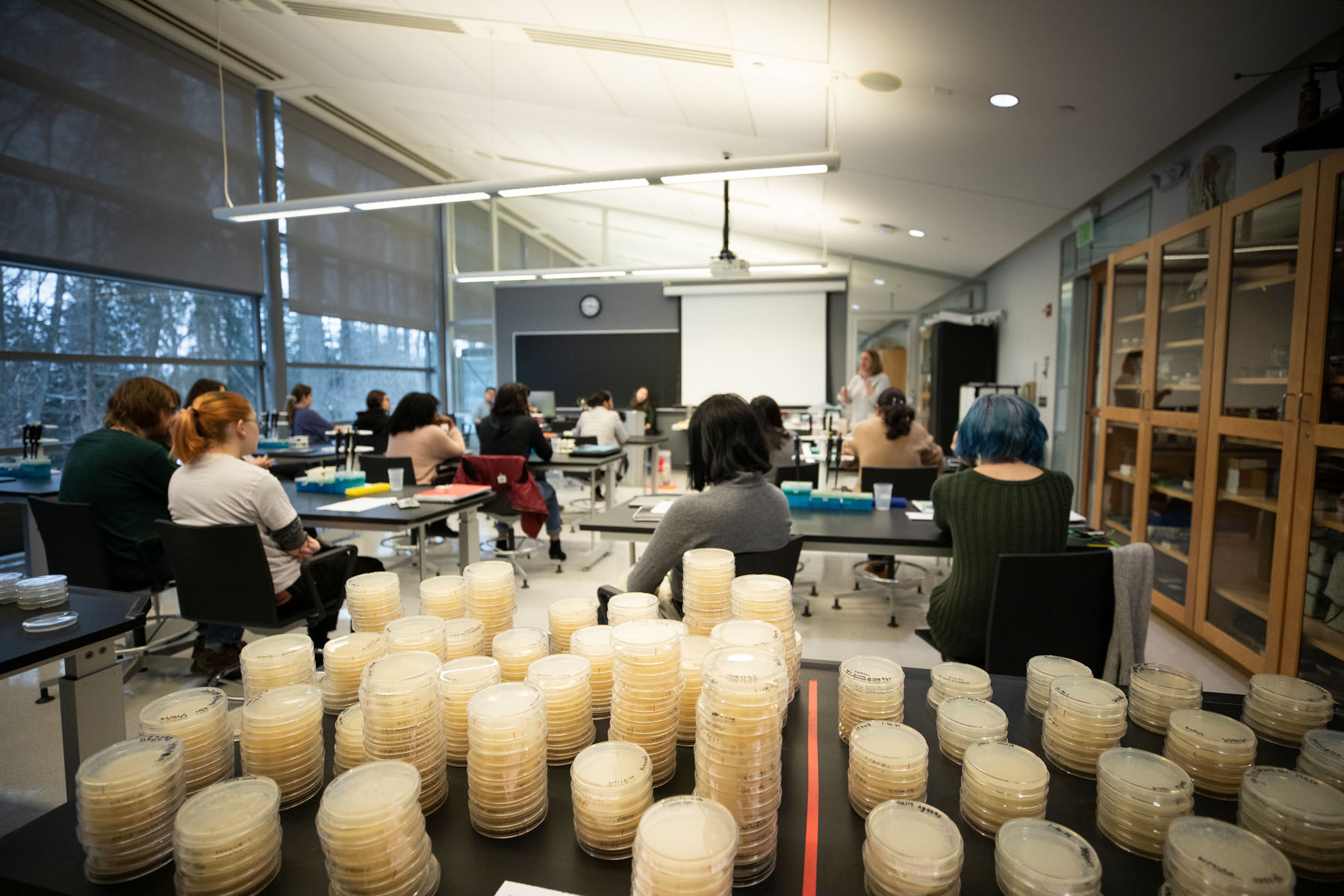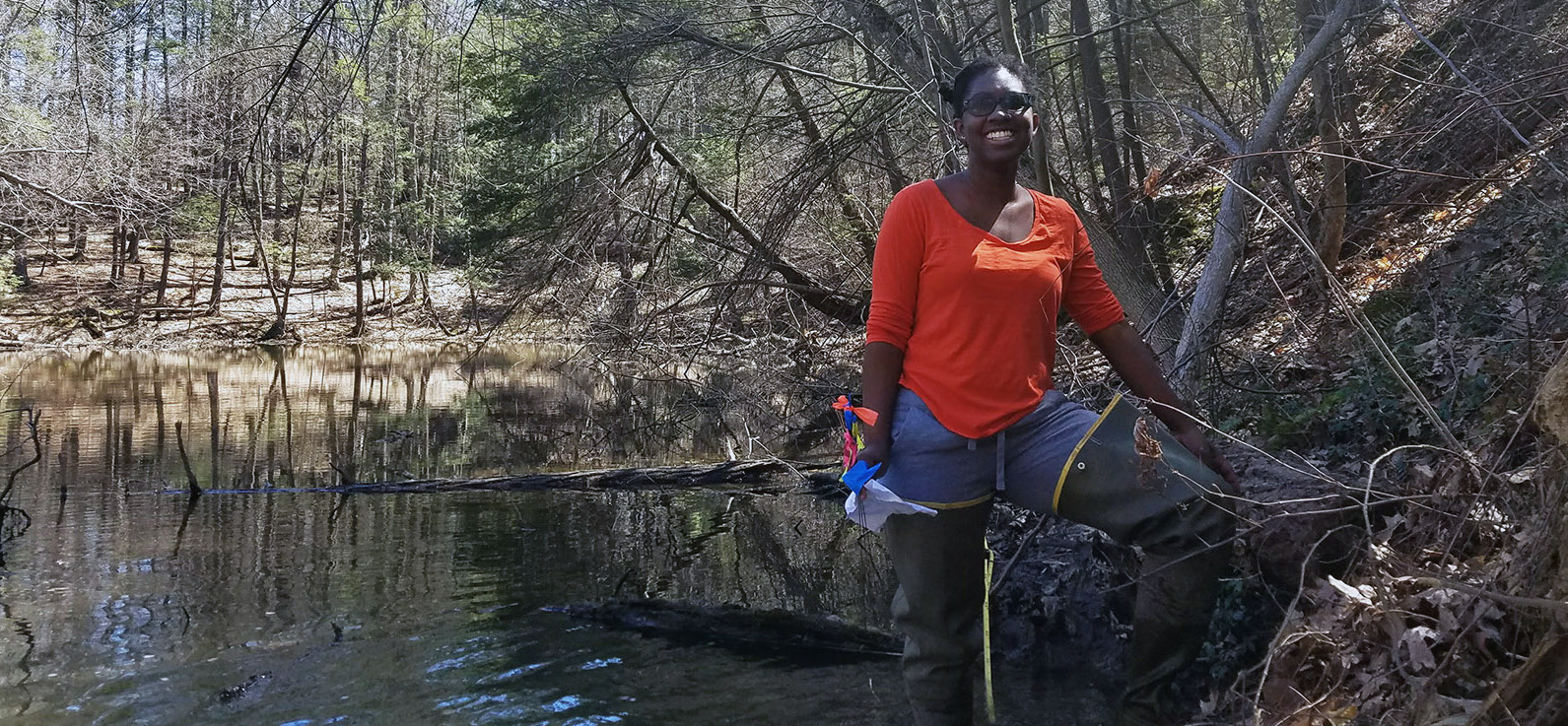Environmental Studies
Photo by Pete Mauney ’93 MFA ’00
Environmental Studies Concentration
The ES Concentration, housed in the Center for Environmental Sciences and Humanities (CESH), prepares students to address environmental questions in and across a variety of sites and scales, both local and global. Working closely with Environmental and Urban Studies (EUS), Experimental Humanities (EH), American Studies (AS), and the new Mellon Foundation Rethinking Place initiative, will equip them with both practical and theoretical tools emerging from the methods and practices of environmental humanities and sciences. The concentration trains students to engage with the interdisciplinary nature of environmental questions with the goal of addressing environmental justice, cultivating community engagement, hands-on problem solving, and renewed awareness of Indigenous and other marginalized realities, for a new generation of environmental thinkers, policy-makers and activists.
overview
The scope of the ES Concentration is regional, national, and global. The ES Concentration takes advantage of its immediate surroundings, using the campus and region as a laboratory for natural and social science research and interpretation through language and the arts. The Hudson River estuary, with its wetlands and watershed, is framed by the Catskill Mountains to the west; its valley communities offer a variety of historical and natural resources.

REQUIREMENTS (20 Credits)
Successfully complete (or be enrolled in) EUS/ES 100: TITLE TBD
Successfully complete one other EUS/ES cross-listed course
Fulfill moderation requirements of the primary program.
Demonstrate a clear idea of how the ES concentration will work with your major program of study in short paper (or, if not moderating simultaneously into a primary program, submit a separate two- to three-page paper addressing this question).
At least one member of the Moderation board should be a faculty member affiliated with ES.
EUS/ES 100
EUS/ES cross-listed course (100 level or above)
2 additional cross-listed courses (200 level or above, one must be outside of major)

on campus
On campus, the Community Sciences Lab, Bard Archaeology, the Bard College Farm, Bard Arboretum, and the unique landscape, architecture, and history of Montgomery Place offer academic and cocurricular activities. The Bard College Field Station is home to Hudsonia, an independent environmental institute, and the Saw Kill Watershed Community (SKWC) and the Roe Jan Watershed Community (RJWC) bring campus and community members together for science, stewardship, and education.
Other place-based partners include the American Eel Research Project in partnership with the New York State Department of Environmental Conservation, Historic Red Hook, Franklin D. Roosevelt Presidential Library, Cary Institute of Ecosystem Studies, Scenic Hudson, Riverkeeper, Hudson River Watershed Alliance (HRWA), Hudson River National Estuarine Research Reserve, and Hudson River Sloop Clearwater.
Students can also explore international affiliations and institutions through a rich variety of internship and study abroad programs, and take courses with leading practitioners at the Bard Globalization and International Affairs Program in New York City.
Students with an ES concentration and a strong foundation in science, policy, and/or economics may apply to the 4+1 program with the Bard Center for Environmental Policy, earning in five years a BA and a master of science in environmental policy or in climate science and policy or an MEd in environmental education.
Courses
Gidon Eshel
The focus of this discussion-based seminar is the disproportionate shouldering by some communitie of environmental burdens exerted by human actions. Of such communities, we focus on those characterized by race or ethnicity, e.g., native Americans, African Americans, central American migrants; by poverty; by immigration status; or by a combination of those criteria. While social aspects of this uneven burden are widely discussed, the natural science manifestations are not. This gap is what this new course strives to bridge. While some discussion on politics and societal considerations is inevitable, our focus will steadfastly remain on the natural sciences, i.e., the physics, chemistry, biology and geology that govern environmental disenfranchisement of the above communities. The geophysical origins, mechanisms, and consequences of preferential vulnerability of the above communities we will discuss include storm surge, subsidence due to sediment flux cutoff, or forest fires. We will also address agricultural chemical toxicity, water quality degradation due to agricultural eutrophication and fracking, differential quality of municipal water systems, as well as exposure to air pollution by proximity to oil and gas facilities, transportation corridors or large scale agricultural production. You do NOT need deep mathematical roots or physical intuition. When I used math, it will be entirely self-contained and fully explained in class. Our key tool is reading scientific papers, and discussing them in class. If you are the silent type, who like to sit passively and not partake in the discussion, this class is emphatically not for you. The key requirement of this class is active, thoughtful participation in class discussion following careful, methodical reading of assigned material. To be in this class you must feel prepared and ready to engage with such diverse readings as scientific papers (our principal source) as well as cogent opinion pieces. You must also be comfortable expressing yourself clearly, using facts (as opposed to assertions) to back up your views, and be comfortable with courteously and respectfully handling opposing views.
Gidon Eshel
“Can one produce local, organic food with relative environmental impunity?” Life cycle analyses show that on a national average level transportation is relatively unimportant in the overall environmental footprint of food production. While this may cast serious doubt on the “local food” notion, the picture may change significantly when organic food production is addressed because of the absence of environmentally adverse agrochemicals from the organic life cycle. In the northeast, vegetable production must be housed in environmentally demanding greenhouses in the winter months. In this course, we strive to answer the question above quantitatively, using an on-campus innovatively designed greenhouse. This is a practicum course, with out of class and weekend participation, which emulates (in miniature) a commercial setting. Preference will be give to juniors and seniors from all fields of study with scientific and math skills in manipulating numbers, with no more than addition and multiplication of numbers.
Kris Feder
What on Earth are humans supposed to eat? This question is often overlooked in critiques of industrial agriculture, yet nutrition science and evolutionary biology indicate that today’s food system—based on highly processed grains, soy, and seed oils—is implicated in the soaring rates of diabetes, heart disease, obesity, autoimmune disease, and even psychological disorders. Moreover, the industrialization of agriculture has accelerated environmental damage from soil erosion, nutrient loss, greenhouse gas emissions, water pollution, and deforestation. The widespread use of synthetic nitrogen fertilizers explains much of the increase in food production since 1950, as the human population has tripled. How many humans can extract a nutritious diet sustainably from a given land base? Globalization and rising concentration in agricultural production, food processing, and distribution have transformed food systems around the world. The coronavirus pandemic has disproportionately affected migrant farm workers and meat processing plant employees, and has shut restaurants and dislocated supply chains. What are the obstacles to reforming food systems toward more sustainable and appropriate practices? We review the history, economics, and politics of food systems, with particular focus on United States policies.
No prerequisites.
Gidon Eshel
The Dust Bowl―the prolonged, sustained and widespread drought that ravaged the southern Great Plains throughout the 1930s and early 1940s, and the blowing sand and soil that accompanied it―is arguably the single most devastating environmental catastrophe in U.S. history. It emptied the Southern Plains of a full one third of their pre-drought population, turned one of the most rapidly expanding regions (in both population and economic activity) of the then still principally rural nation into sterile, deserted wasteland, and inflicted almost unimaginable physical and personal suffering on those who stayed. It is also a nearly perfect example of how a natural, entirely expected, human-impacting phenomenon can be turned into the unmitigated regional catastrophe that it was by ill-conceived human action. The Dust Bowl is thus a classic case study in human–environment interactions that holds invaluable lessons for the future. In this class, we will review, in mechanistic details, the physical (climatological, hydrological, agroecological, geomorphic) elements of the Dust Bowl, and place them in historic/economic context wherever appropriate.
Elias Dueker
This course offers a detailed exploration of the earth’s hydrosphere and its interactions with the biosphere, lithosphere, and atmosphere. Topics will include origins of the hydrosphere, origins of life, the global hydrologic cycle, and anthropogenic influences on aquatic ecosystems. We will further explore pressing global environmental issues associated with the hydrosphere: climate change, protection of drinking water resources, freshwater and marine ecosystem degradation, and waste water treatment. Lab work will be guided by scientific questions related to these issues, and will focus on detection of anthropogenic influence, management and maintenance of water resources, and frontiers of scientific approaches to sustainable human interactions with water resources. Labs will include field sampling, lab analysis, and computer modeling to improve understanding of the ecological ramifications of water pollution in marine, estuarine, and freshwater ecosystems.
Prerequisites: EUS 102, Bio 202, or permission of instructor.
Class size: 16
Elias Dueker
Recent global catastrophes including the Covid19 pandemic and unusually destructive wildfires have highlighted the importance of equitable access to clean air in human and ecological health. While air is the fluid humans engage with most intimately, we are not generally aware of whether or not the air we are interacting with is “clean.” Environmental racism in the US has resulted in an inequitable distribution of clean air, which has in turn given birth to the powerful movement for environmental justice. This class will be devoted to learning the scientific principles behind measuring and managing air quality on a local, regional, and global scale. We will be interacting with other Bard (OSUN) network institutions to think cross-disciplinarily and cross-nationally about the global nature of air “management” and to creatively address the scientific needs of local and regional community members working toward reducing air pollution. Lab work will be guided by scientific questions generated by communities including Kingston, NY and Bishkek, Kyrgysztan. Specifically, students will manipulate models to conduct field sampling, and utilize microbiological and chemical assays in the lab to better understand sources for and tracking of contaminants in air and the implications for people breathing that air.
This course is part of the Racial Justice Initiative, an interdisciplinary collaboration among students and faculty to further the understanding of racial inequality and injustice in the United States and beyond.
Beate Liepert
Understanding the scientific facts of a changing climate in the past and present will guide our decision making today for a climate future 20, 50 and 100 years from now. In this course we will explore how greenhouse gases and other man-made disturbances impact Earth’s climate, how ongoing and projected future anthropogenic changes compare to natural variability, and discuss implications of climate change to human and natural systems. Climate policies, pathways and strategies for adaptation and mitigation are further topics of this course. This course has a lab component in which physical principles are explored in hands-on experiments, climate data analyses using computer models (including climate simulations). Climate issues you care about can be explored in group projects. The course has no prerequisites but basic knowledge of spreadsheets and some physics and math is advantageous.
Gautam Sethi
This course will expose students to a variety of modeling techniques used in environmental decision-making. The inclusion of these techniques in this course is motivated by their relevance in generating useful answers to current policy issues. For example, how rapidly should the switch to renewable energy generation be made? The answer to this question depends on, in part, the rapidity with which fossil fuels are being depleted. This course will introduce the concept of peak oil and use statistical methods to estimate the timing of peak global crude oil production. As another illustration, international development agencies have introduced new varieties of rice in Laos in a bid to make rice yields less susceptible to climate change. The impact of this intervention on livelihoods of small landholders, however, is uncertain due to inherent fluctuations in many factors such as the market price of rice. In this course, we will use data collected by the UNDP to conduct a Monte Carlo simulation and develop a probabilistic answer to this issue. Other examples of relevant policy issues discussed in this course include developing simple predator-prey models to predict changes in populations of keystone species, and modeling the sustainability of fisheries under various regulations of regional fisheries councils in the United States. Students are expected to have some basic knowledge of regression analysis and be proficient in Calculus I. While it is desirable that students have some prior coding experience, the course will begin with a three-week primer on MATLAB programming.
Prerequisite: MATH 141, Calculus I
Elias Dueker and Krista Caballero
Cross-listed: American Studies; Experimental Humanities; Human Rights
We generally assume maps are objective, accurate representations of data and the world around us when, in fact, they depict the knowledge, experience, and values of the humans who draft them.
As a hybrid EUS practicum + colloquium, this course will explore ways in which ecological issues are entangled with colonial histories of racism and supremacy, resource extraction and expansion through mapping. Native American scholarship will ground our exploration as we consider the impact and consequences of mapping as a tool used historically to claim ownership and invite exploitation.
We will also investigate the evolution of radical cartography to counter these practices and imagine alternative mapping for more just ecological futures. A series of Indigenous scholars and activists will provide an opportunity for students to learn from experts working at the forefront of their fields to address environmental injustices locally, nationally, and internationally. These guest lectures will be paired with hands-on projects that explore mapping as a tool for environmental advocacy alongside artistic and counter-mapping approaches that experiment with ways we might communicate scientific and humanistic knowledge to a wider audience. In both theory and practice this team-taught course aims to reconsider and transform ways of engaging community science and community action through collaborative inquiry, interdisciplinary experimentation, and meaningful cross-cultural dialogue. This course is part of the Racial Justice Initiative, an interdisciplinary collaboration among students and faculty to further the understanding of racial inequality and injustice in the United States and beyond.
Jennifer Phillips
In this course we will examine the linkages between agroecosystems and the climate system. We begin by looking at projections for climate change impacts on crop production, with a focus on crop simulation models, their applications and limitations. We then look at expectations for the influence of elevated CO 2 on yield, and controversies involved. We then turn to a discussion of the role that agriculture can play in climate change mitigation, given the large greenhouse gas emissions associated with farming systems. This takes us to an in-depth discussion of soil carbon management, and trade-offs between emissions from various reductions strategies. Finally, we will investigate the various strategies being put forth regarding climate change adaptation, including the role of genetically modified crops, biodiversity, and system resilience, with major implications for future food production. This is a graduate course offered to a limited number of undergraduates. Interested students should contact Jennifer Phillips.
Susan Winchell-Sweeney
Cross-listed: Historical Studies; Human Rights
Using ESRI GIS software and associated apps, students will receive formal instruction in the fundamentals of using spatial information, conducting spatial analysis, and producing high-quality cartographic products. Students will learn how GIS may be used as a tool for identifying and assessing environmental justice (EJ) issues at the local, regional and global scale. Students will apply these GIS skills and knowledge base to a team-based research project focused on an environmental justice problem. The course culminates in a presentation session, where students show their analysis and results to their peers, professors and the greater Bard community. This course is part of the Racial Justice Initiative, an interdisciplinary collaboration among students and faculty to further the understanding of racial inequality and injustice in the United States and beyond.
Kwame Holmes
This course-practicum will bring students into the ongoing work of the Kingston Housing Lab. This project combines critical geography with the politics and philosophy of prison abolition, bringing both to bear upon the struggle for housing justice in Kingston, New York and Ulster county. Students will engage latest academic literature on housing insecurity and evictions as an ongoing crisis in late-capitalism, receive training in ArcGIS, and participate in our efforts to repair relationships between tenants and landlords. Though a small town, Kingston, NY is in the midst of a housing crisis, one that has been exacerbated by COVID-19 and which is driven by the regional and global flow of capital into real estate in small towns near and far. Kingston Housing Lab students will have an opportunity to directly intervene in these issues at a critical juncture in global history.
Peter Klein
How do urban processes of growth, decline, and revitalization affect different groups, particularly along dimensions of race, class, and gender? This place-based research seminar course looks closely at this question by examining the historical, political, and social landscape of Kingston. We will use this nearby city as a case to explore theories on urban transformation and the contemporary challenges that face small urban centers. In particular, the course will use the lens of environmental inequality to examine the effects of historical processes, as well as to investigate how residents and government officials are addressing pressing problems. The course will look specifically at issues of food justice, pollution, access to resources, environmental decision-making processes, and housing security. We will visit Kingston as a class, and students will develop and carry out their own project with a community partner. (This course fulfills the practicum requirement for moderated EUS students.) Admission by permission of the instructor. This course will usually meet every other Friday from 10:10-12:30, but students must be available from 9:00-1:00, in order to allow for off-campus trips.
Please note that this is the second semester of a two-semester course. Students must have taken the first section of the course in fall 2021 to enroll.
Monique Segarra
During this course, students analyze the political forces that impact the policy making process and the legal and regulatory instruments that have been developed to protect the environment and human health. The class provides a political framework to capture the dynamic and complex relationships between these and other critical factors − scientific, economic, cultural, institutional and ethical − that influence how society responds to environmental problems from the local to international levels. In addition, this class will help us track and navigate the larger political context that has provided openings for the modern environmental movement to emerge in the United States during the 1960s, and the advancement and retrenchment of environmental law and policies over time. The analytic framework that we use to help us think systematically across complex policy issues/arenas and over time is built on the inter-related concepts of ideas, interests and institutions. One of the primary goals of this course is to enable you to approach any environmental issue and to make sense of it by using this frame analysis. For example, what are the dominant (and often contentious) ideas about what constitutes a policy issue or a policy problem to be solved? Who are the critical actors or interest groups that shape both a definition of the problem and its solution, or who can support or block a policy/program during its implementation? What are the kinds of institutional factors that shape policy formation and implementation –from federalism in the United States or Mexico, to bureaucratic rules, national laws and political venues such as congress, state legislatures, local government, bureaucratic agencies or cultural beliefs -to name only a few!
Class size: 5
Monique Segarra
This course analyzes the dynamic and complex relationship among various factors—legal, political, cultural, and ethical—that influence the environmental policy-making process. It uses a case-study approach to introduce students to the core concepts of environmental policy making and environmental policy cycles that include defining the environmental problem, setting the environmental agenda, and presenting and implementing policy solutions. Students examine state and social responses to new and ongoing environmental problems. In the United States context, this includes taking into account the nature of state-federal relationships in developing and applying the environmental law, as well as the evolving role of technology, tensions between private and public interests, and equity considerations. In addition to U.S. environmental policy, the course explores international environmental regime development, conflict resolution, and transboundary citizen networks that influence global environmental decision making. Open to moderated students.
Prerequisite: Environmental Policy I
Elias Dueker
According to the UN, over 4.2 billion people on earth do not have access to effective sanitation, including citizens of the richest countries in the world. In New York City, NY, USA, at least 20 billion gallons of raw (untreated) human sewage spew into the Hudson River Estuary annually. Residents of Mt. Vernon, NY (located in one of the richest counties in NY state) regularly must remove solid and liquid waste from their own overflowing toilets and basements as sewer pipes that are more than 100 years old and 100 feet deep disintegrate. Humans have long known that proximity to waste causes illness, based on Indigenous science and cultural knowledge (also known as wisdom or common sense). Western science caught up with this over 100 years ago to again directly link raw sewage in water and soil to typhoid, dysentery, hepatitis, cholera, E. coli, salmonella, hookworm, and myriad other human diseases. These devastating illnesses can be eliminated with effective sanitation, yet roughly half of the human population do not have access to this protection.
This seminar-style course will study the science of wastewater treatment and contemplate contemporary case studies of communities with unreliable/nonexistent waste infrastructure in the United States. Together, we will track the direct interactions of policy, science, and the societal barriers of racism, sexism, and classism on achieving equal access to adequate sanitation for all people. Through close readings of scientific literature, guest speakers (environmental justice activists, sewage scientists, climate scientists, citizen scientists), and discussions highlighting common sense/science (e.g. shared experiences of “using the bathroom”), students will participate meaningfully in the pressing pursuit of solutions to the sanitation crisis, which environmental justice activist Catherine Coleman Flowers calls “an undeniable public health disaster.”
ES STEERING COMMITTEE
WHAT WE DO
WHO WE ARE
ES Concentration Co-Director
M. Elias Dueker
ES Concentration Co-Director
Beate Liepert
Social Studies
Peter Klein
Science, Mathematics, and Computing
Cathy Collins
The Arts
Olga Touloumi
Languages and Literature
Peter L’Official

